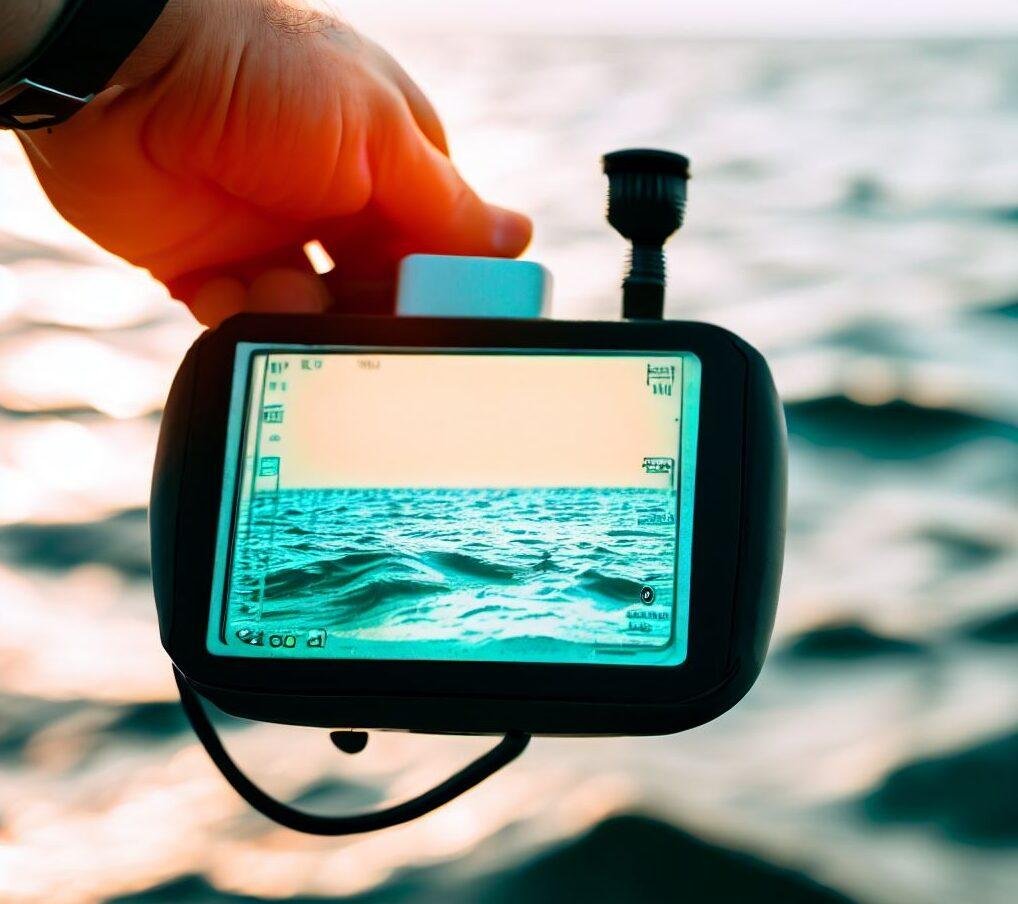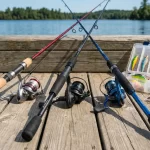Have you ever found yourself struggling to locate bass while fishing? I used to face the same problem until I discovered the magic of a fish finder. In this how-to guide, I will show you how to find bass using a fish finder effectively.
Whether you’re a seasoned angler or a beginner, this article will provide all the necessary information and tips to make your fishing trips more successful. So, grab your fishing gear and get ready to become a bass-finding expert!
Table of Contents
Quick Tips
Tip 1: Adjust the sensitivity. Start by turning your fish finder’s sensitivity to a higher setting to see the maximum information displayed on the screen. Then, gradually decrease the sensitivity until you can see the fish icons without clutter.
Tip 2: Look for structure and cover. Pay attention to areas with submerged rocks, fallen trees, or weed beds. Bass like to hide in these spots for protection and food. Use your fish finder to identify and target these structures for potential bass.
Tip 3: Find the depth. Bass tend to stay at certain depths depending on the time of day and water temperature. Use your fish finder’s depth reading to locate the level where the bass will most likely be. Adjust your fishing technique accordingly to target that depth.
Tip 4: Watch for baitfish. Bass often follow schools of smaller fish like shad or minnows. If you spot dense concentrations of baitfish on your fish finder, it indicates that bass may be nearby. Cast your lure or bait in those areas to increase your chances of finding bass.
Analyze the structure: Focus on underwater formations for potential bass hiding spots.
Analyzing the structure of a body of water is essential when it comes to finding the best fishing spots for bass. To find potential hiding spots for bass, focus on underwater formations. These formations can provide shelter and cover for the bass, making them ideal places to cast your line. Here are some step-by-step tips and tricks to help you analyze the structure and locate those bass-hiding spots.
First, study a map of the water body you plan to fish in. Look for changes in depth, such as drop-offs, ledges, or underwater hills. These variations in the terrain can create hiding spots for bass. Next, observe the shoreline and any visible structures, like fallen trees or submerged vegetation. Bass often lurk in these areas, so note them for future reference.
Once on the water, use your fishing electronics, such as a fish finder, to identify underwater structures. Look for areas with rock formations, submerged stumps, or vegetation beds. These can attract bass as they offer opportunities for ambush and protection. Additionally, watch for any signs of baitfish activity, like schools of minnows or jumping fish. These areas are often frequented by bass looking for an easy meal.
By analyzing the structure of the water and focusing on underwater formations, you can increase your chances of finding the best hiding spots for bass. Remember to study maps, observe shoreline features, and use fishing electronics to locate potential hotspots. These tips and tricks enable you to find those elusive bass and improve your fishing success.
Identify Bass on Fish Finder in 3 Easy Steps! | Fishing Sonar Basics
Watch the tutorial
Identify underwater vegetation: Utilize fish finders to locate bass-friendly plant life.
When you’re out on the water, knowing where to find the best underwater vegetation for fishing is important. One useful tool to help you locate bass-friendly plant life is a fish finder. With its sonar technology, a fish finder can detect and display underwater objects, including vegetation, on a screen.
To identify underwater vegetation using a fish finder, start by selecting the sonar mode and adjusting the sensitivity to a level that works best for your fishing environment. As you move your boat around, focus on the screen and look for areas where you see thick clusters of lines or dots. These are indications of underwater vegetation, which could provide a good habitat for bass.
Once you’ve identified a potential area with underwater vegetation using your fish finder, it’s time to get a closer look. Position your boat near the vegetation indicated on the screen and slowly approach the area. Keep an eye on the fish finder screen as you get closer and look for any changes in the display patterns.
Healthy underwater vegetation will often show up as thicker and denser lines or dots, indicating a rich and robust environment that can attract bass. Additionally, you may notice fish symbols appearing on the screen, which could signify that bass are feeding in the area.
To confirm that the underwater vegetation you’ve located is indeed bass-friendly, it’s essential to observe the behavior of the fish. Using your fishing gear, cast your line near the vegetation and pay attention to any bites or movements on your rod.
If you’re getting bites or feel the fish tugging on your line consistently, it’s a good indicator that the area is rich in bass due to vegetation. Remember to take note of the surrounding conditions, such as water temperature and depth, as this information can help you replicate your success in similar areas on future fishing trips.
Explore drop-offs and ledges: Look for sudden changes in depth to target bass.
When fishing for bass, one of the key techniques you should use is exploring drop-offs and ledges in the water. These sudden changes in depth are a favorite hiding spot for bass, making them an ideal target for you.
Locate areas where the water suddenly gets deeper, such as near cliffs, submerged trees, or underwater structures. Once you find a drop-off or ledge, cast your bait near it and let it sink slowly. The bass waits at the bottom or along the edge, ready to strike.
To effectively explore drop-offs and ledges, it is important to use the right type of bait. Soft plastic worms or creature baits work well, as they mimic the natural prey of bass and are enticing to them. Choose a color that matches the water conditions, such as a darker shade if the water is murky. As you cast your bait near the drop-off or ledge, let it sink gradually, keeping an eye on your line for any sudden movements or bites. If you don’t get a bite after a few minutes, try a different bait or change your presentation.
Remember that exploring drop-offs and ledges is not limited to a specific time of day. Bass can be found in these areas throughout the day, so exploring them at any time is worth exploring. Remember to be patient; bass can be finicky and may not always bite immediately.
Mastering this technique and learning to read the water will increase your chances of landing some impressive bass. So get out there, explore those drop-offs and ledges, and enjoy the thrill of reeling in the big one!
Monitor temperature differentials: Seek areas where warm and cold waters meet.
One important aspect of monitoring temperature differentials is to seek areas where warm and cold waters meet. Doing so lets you gather valuable information about the ocean’s currents and the mixing of different water masses.
To begin, find a suitable location where warm and cold waters are likely to meet, such as near the coast or where the offshore winds converge. Look for visible signs of water temperature changes, such as a noticeable difference in color or the presence of thermoclines.
Next, equip yourself with the necessary tools to measure the temperature differentials accurately. A reliable thermometer, preferably a digital one with a waterproof casing, is essential. Ensure that you position the thermometer correctly in the water to get an accurate reading. Ideally, submerge it below the surface where the warm and cold waters converge, ensuring it is not affected by your body temperature or sunlight.
Once you have gathered the temperature data, record it in a journal or notebook for future reference or analysis. Keep track of the time, location, and temperature differentials you measured.
By monitoring temperature differentials over time, you can identify patterns, detect changes in oceanic conditions, and gain insights into the dynamic interactions between warm and cold waters. This information can be valuable for scientists studying climate change, marine life distribution, or recreational activities such as fishing or swimming.
Conclusion (how to find bass on a fish finder)
Understanding how to find bass on a fish finder effectively will improve your fishing experience and increase your chances of catching fish. When you analyze the structure, identify underwater vegetation, and explore drop-offs and ledges, you can pinpoint bass hiding spots and increase your chances of catching more fish.
Utilizing the features of a fish finder allows you to maximize your time on the water by efficiently locating the areas where bass are most likely to be present. So, whether you are a seasoned angler or just starting out, understanding these techniques will undoubtedly improve your fishing skills and ultimately enhance your overall enjoyment of the sport.
FAQs (how to find bass fish finder)
Q1: What is a fish finder, and how does it work?
A1: A fish finder is a device that uses sonar technology to locate fish underwater. It works by emitting sound waves (sonar signals) that bounce off objects in the water, including fish. The device then interprets these signals and displays them on a screen, allowing anglers to identify and locate fish.
Q2: Are fish finders effective in locating bass?
A2: Yes, fish finders are highly effective in locating bass. Since bass are known to hide near underwater structures such as rocks, vegetation, or drop-offs, fish finders can precisely identify these structures and help anglers spot bass hiding spots.
Q3: What are the key features to look for in a fish finder for bass fishing?
When choosing a fish finder for bass fishing, consider the following features:
1) High-frequency sonar: Look for a fish finder with a higher frequency range (200 kHz or more) as it provides better resolution, especially for locating small or tightly grouped bass.
2) GPS/chartplotter functionality: This feature enables you to mark productive bass spots, track your route, and analyze the depth and structure of the water.
3) Side imaging/down imaging: These features provide detailed visuals of the underwater structures, making it easier to locate bass.
Q4: How can I interpret the images displayed on my fish finder?
A4: Fish finders typically display a range of information, including water depth, temperature, contour lines, and fish arches. To locate bass, look for cluttered areas indicating the presence of underwater vegetation or drop-offs, and keep an eye out for arches that represent fish, including bass.
Q5: Can fish finders distinguish between different fish species, including bass?
A5: Fish finders can differentiate fish species to some extent, but they may not always identify them accurately. However, you can make educated guesses based on the size and behavior of the fish shown on the screen. Experienced anglers usually develop a knack for recognizing bass from their distinct behavior and appearance on the display.
Q6: How can I use my fish finder to track bass movements?
A6: To track bass movements using a fish finder, utilize the device’s GPS/chartplotter feature. Mark potential bass-holding spots, such as points, submerged structures, or areas with high fish activity. Explore different depths and structures while monitoring your fish finder’s display for signs of bass. Over time, you’ll gain insights into water conditions and patterns leading to successful bass fishing.
Q7: Are there any tips for using a fish finder to find bass?
A7: Here are a few tips for effectively using a fish finder to locate bass:
1) Familiarize yourself with the device: Learn how to adjust sensitivity, frequency, and other settings to optimize the fish finder’s performance in different conditions.
2) Observe the behavior of bass on the display: Take note of how bass appear on the screen, such as their size, position, and movement patterns.
3) Combine fish finder with other techniques: Use your fish finder in conjunction with other fishing techniques, such as casting to potential spots indicated by the device or using different lures to attract bass.
Remember, acquiring skills in interpreting fish finder data takes time and practice. Being patient and observant will enable you to improve your ability to locate bass effectively using a fish finder.







